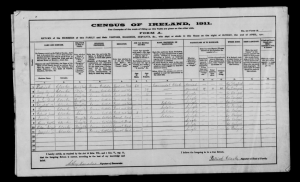by Kieran Kelly, Donegal Historical Society
I was delighted to have been asked to participate in the Letters of 1916 project when it visited Letterkenny in March 2016. The letter that I chose was written by Patrick Clarke, from Letterkenny to Dublin Castle on May 31st, 1916. In the letter, he speaks about his 14 year old son and how he was hoping to get him on board a training ship for the Naval Department but as he was too young, he was hoping that writing this letter could persuade the department.

Looking at the 1911 Census I found a Patrick Clarke, 42 years old, Roman Catholic, living at Slate Row in Letterkenny. He was originally from Co. Wexford and was married to Mary Agnes Clarke with 10 children – Mary Agnes (15), Jane Sarah (14), Elizabeth (12), Teresa (10), Patrick James (8), Isabel (6), Annie Josephine (6), Aileen Bridget (2) and Joseph (4 months). Given that this is the only Patrick Clarke living in Letterkenny at the time and that his son is 8 in the 1911 census, making him 14 by the writing of the letter, I was able to conclude that this was the same man.
What I found interesting about the letter was why would he want his son enlisted only a matter of weeks after the Rising? When we hear the word “1916”, we automatically think ‘Easter Rising’, but it is also important to remember that other things were on people’s minds that year. From the letter, we know that Patrick Clarke’s reason for wanting his son to enlist was for him to attain discipline as his mother was ‘unable to keep him from company that is not healthy for him’, but it is important to also place it in the context that World War 1 had been raging for almost two years at this stage. Almost 200,000 men from Ireland fought in that war (plus another 300,000 Irish immigrants or people with Irish parents). Of these somewhere between 35,000 and 50,000 Irishmen never returned home, including 1,200 from Donegal and approximately 91 from the Letterkenny area.
The standard reason that has been accepted by so many people for so many years for Irishmen enlisting in the British Army was that they needed ‘the King’s shilling’ and while this may have been true for some recruits, it was certainly not the sole reason. There were many, many reasons why an Irishman at that time would enlist, not least when they heard what their local clergy and politicians were telling them about the plight of “Catholic Belgium”.
For example, at a public meeting in the Market Square, Letterkenny on Sunday September 27th 1914, Fr. John McCafferty, Administrator in the Cathedral and staunch Nationalist, stated: “German armies of destruction are let loose on Belgium. Her churches and her homes, her libraries and Universities are destroyed, and Belgian soil is drenched with the blood of her people. If justice is to prevail, the wrongs of Belgium must be righted, and the sympathies of right-thinking men will be with her.”
Edward Joseph Kelly, Irish Party MP for the area also spoke at that meeting: “We in Donegal have already sent men to fight on the plains of France and to beat the invader on his ground when the time comes. We are proud of those men who are gone and we wish them a hearty God-speed and a safe return”
When hearing these emotion-fuelled speeches from their local clergy and politicians, it is not surprising that so many saw it as their duty to enlist.
Sympathies towards the war effort are also reflected in the setting up of a committee in Letterkenny to assist Irish prisoners of war by sending cases of comforts while there was also a series of war charity concerts organised by Thomas McFadden, chairman of the Urban District Council. Of course, the locality was also kept informed regularly of the deaths of their fellow townspeople through weekly newspaper reports. It is worth noting that in Easter Week, when the rebels were fighting in Dublin, three Letterkenny men died in the War: Patrick Doherty from Oldtown died on 27th April 1916, Michael Doherty from Church Street died on 29th April 1916 and Sgt. John McCafferty from Port Road also died on 29th April 1916.
There are 25 recorded deaths of Letterkenny people in 1916, 8 died in the Battle of the Somme between July and November 1916, 4 of them on the very first day of the battle. From these statistics, I think it’s fair to say that in 1916, the thoughts of the people of Letterkenny weren’t with the small band of rebels in Dublin.

Another probable influence on enlisting was the presence of refugees from Belgium. Following the destruction wreaked by the Germans in their advance to France, many Belgians were left homeless and in Letterkenny, a Refugee Committee was set up to assist them. On Tuesday 12th January 1915, ten Belgian families of 48 people arrived in the town and were received by Bishop O’Donnell at the train station. The families that arrived were housed in the new council houses that had recently been built at Ballymacool Terrace – or Slate Row, houses right beside the Clarkes. Living so close to the Belgian Refugees and hearing of their plight would naturally have caused an influence on the Clarke family.
From newspaper reports, we know that Letterkenny at this time was very much a John Redmond and Home Rule supporting town. By September 1914, with Home Rule receiving its Royal Assent, the Nationalists took to the streets to celebrate. Houses throughout the town were decorated with flags and bunting while at Sentry Hill, the Market Square, and at various street junctures large bonfires blazed, and all around the town the hilltops and hillsides were lit up. As Home Rule was suspended for the duration of the war, the Nationalists believed their dream of Home Rule would become a reality once the war was over.
However, all that would change with the Easter Rising, although not immediately. This letter was written a month after the Rising took place and, as we know, initially the rebellion was condemned. In a meeting of the Letterkenny Guardians of 6th May 1916, three days after the shooting of Padraig Pearse, Chairman Philip Carroll commented on the revolt that had taken place in Dublin the week before: “Perhaps you would propose a resolution condemning the action of the men who created these troubles in Dublin.” Edward Lynch responded, “I would not think twice about doing that!” Mr. Carroll then stated “I think it would be a proper thing to condemn the actions of these soreheads”. When the clerk interjected, that “You had better keep your names out of the press,” Mr. Carroll responded, “Why should we? If a man hasn’t the courage of his convictions he may keep himself under the table.” The resolution finished in mockery when he stated “I am afraid they got more than sore heads” and there was laughter. At first, the majority of the Nationalist population of the town appeared to share this animosity towards the insurgents, so again, it is not a surprise to see a Roman Catholic commercial clerk such as Patrick Clarke wanting his son enlisting in the army.
However, while the executions in Kilmainham Jail gradually brought sympathy for the rebels, it wasn’t until the following year that events predicated the significant rise in Republicanism. In August 1917, the RIC broke into the Literary Institute in search of arms belonging to the Volunteers. No arms were found but this destruction of church property greatly angered the people of the town. Fr. McCafferty warned that this wanton destruction would have the effect of “turning the people away from constitutional guidance to meet force by force.”
The following month, the first Sinn Féin club was formed in Letterkenny with Dr. J.P. McGinley as President. On St. Stephen’s Night 1917, the club received a great boost with the arrival of the mother, niece and sister of Patrick and Willie Pearse at a ceilidh held in the Club Hall. Gradually, over the subsequent weeks and months, membership of the Sinn Féin club grew as more and more people moved away from the United Irish League and the Ancient Order of Hibernians. By February 1918, the club had a membership of almost 400, holding Gaelic classes two nights each week, and a ceilidh each Sunday evening. By the outbreak of the War of Independence in 1919, support for Republicanism had replaced Home Rule and Nationalism in the minds of many residents of the town of Letterkenny.

This rise in Republicanism is important when considering what befell Patrick James Clarke, the boy of 14 years of age in the letter of 31st May 1916. He never did join the British Army as requested by his father. Instead he joined in the struggle for Independence against the British and later emigrated to America.
His sisters Isabella and Aileen Clarke though, eventually became the proprietors of a well-known local business. This shop was once Carr’s Confectionary but when Nurse Scanlon became the owner, the two Clarke sisters took over the running of the shop, and thus “Clarke’s Newsagents” was born. The current proprietor of this well known shop, Paddy Delap, is the son of Aileen Clarke and is named after his grandfather who wrote the letter, his full name being Patrick Clarke Delap.
In conclusion, I chose this letter as the fate of Patrick James Clarke reflects perfectly the shift in political opinion from Nationalism to Republicanism that was evident in Letterkenny following the Rebellion and the subsequent rise in Sinn Féin. It also reminds us that, locally at least, there was more to 1916 than just the Easter Rising.

Kieran Kelly is a historian with Donegal Historical Society. He was a guest speaker at the Letters of 1916 Community Engagement event held in Letterkenny in March 2016. The event was made possible through a SFI Discover grant from Science Foundation Ireland (SFI).